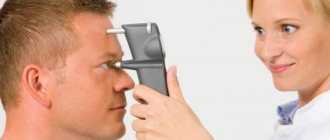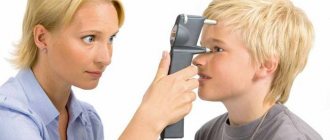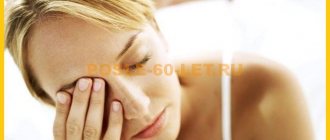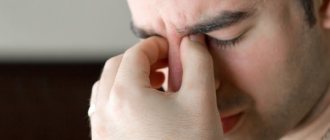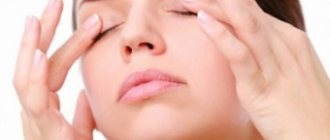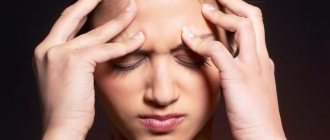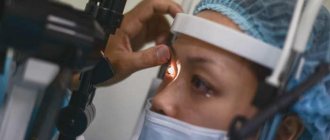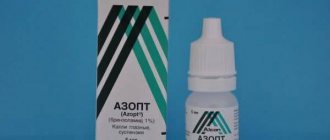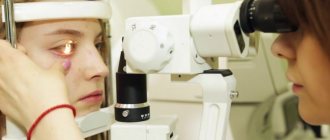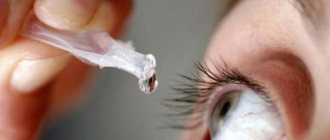It is necessary to reduce eye pressure if it is elevated as soon as possible, because it can lead to optic nerve atrophy and blindness. Some eye diseases may have virtually no clinical manifestations for a long time, however, their consequences for vision are very dangerous. Glaucoma, which is manifested by increased eye pressure, is one of these diseases.
People at risk (especially those with a genetic predisposition) are recommended to undergo regular ophthalmological examinations so as not to miss the development of a serious disease.
People prone to increased intraocular pressure need periodic examinations by an ophthalmologist
Eye pressure
Eye pressure Source: ozrenii.ru A number of eye diseases can develop asymptomatically, but ultimately lead to complete blindness.
One of them is glaucoma. This is a chronic eye disease characterized by increased eye pressure, which can lead to optic atrophy and irreversible vision loss. Therefore, it is very important to find a way to lower eye pressure in time. Glaucoma is a fairly common disease, most often found in patients over 40 years of age, but it can also affect younger people. There are known cases of congenital glaucoma, which is diagnosed in infants.
Eye pressure is measured in millimeters of mercury (mmHg). The normal range of eye pressure is from 12-22 mm Hg. Intraocular pressure is greater than 22 mm Hg. considered above normal.
When IOP is higher than normal but a person has no other signs of glaucoma, the condition is called ocular hypertension. If the intraocular pressure is less than 8 mmHg, then this condition is called ocular hypotony.
In human eyes, there is a constant production of intraocular fluid (aqueous humor), which is concentrated in the anterior and posterior chambers of the eye. The outflow of aqueous humor occurs through a complex drainage system, which is located in the corner of the anterior chamber of the eye.
When the balance between the production and outflow of intraocular fluid is disturbed, which leads to its accumulation, pressure increases. As a result of this process, the eyeball, putting pressure on the optic nerve, destroys it, which causes vision impairment.
Subsequently, peripheral vision is impaired, possible death of the optic nerve and the occurrence of complete blindness. Sometimes there are cases of sudden loss of vision during an acute attack of glaucoma.
Glaucoma can be open-angle or closed-angle. The closed-angle form is characterized by the accumulation of intraocular fluid due to the iris blocking the angle of the anterior chamber of the eye, which impairs access to the drainage system of the eye.
In the open-angle form, access remains open, but the functions of the drainage system are impaired. Glaucoma can also be mixed with normal eye pressure (with a sharp deterioration in blood circulation in the optic nerve).
Questions regarding lowering eye pressure are most often asked by people suffering from glaucoma. The fact is that it is this phenomenon that first leads to the progression of the disease, and then to complete blindness.
How to reduce eye pressure Normally, eye pressure varies between 10-23 mmHg. This is a sufficient level to ensure the maintenance of visual acuity and normal functioning of the retina.
In rare cases, deviations from the norm may be an individual feature. But most often, increased or decreased intraocular pressure indicates eye diseases.
10-23 mmHg is the norm for intraocular pressure; with glaucoma, these indicators increase significantly. Rarely, but still there is normal eye pressure with glaucoma (this type of disease is called normotensive glaucoma).
Ways to reduce intraocular pressure: relaxation
To reduce intraocular pressure, it is important to be able to relax. To do this, it is useful to perform breathing exercises developed by Alexandra Strelnikova. This will normalize your blood pressure.
But this is not enough to completely relax your eyes. You will need another exercise developed by the American ophthalmologist Bates - palming.
Performing this exercise for glaucoma requires strict adherence to the technique:
- Sit on a comfortable chair or stool in front of the table. Place a pillow in front of you to rest your elbows on. The exercise can be performed in a lying position.
- Relax and think about something good. Breathe deeply, imagining as you inhale how oxygen saturates every cell of your body, and when you exhale, it takes away negative emotions and tension.
- Place the fingers of one hand on the fingers of the other hand, crossing them. There should be an angle between the palms.
- Close your eyes and place your folded palms on them so that your crossed fingers rest on the bridge of your nose. You should not interfere with nasal breathing with your hands. The palms should touch the face tightly to prevent light from passing through. Stay in this position for about 5 minutes.
Attention! To increase the effectiveness of the relaxing palming exercise, before closing your eyes, rub your palms together to warm them up.
Causes of the disease
Slight changes in eye pressure from one season to the next, or even within one day, are normal. Intraocular pressure may be affected by exercise and fluid intake.
Temporary changes in intraocular pressure may be caused by excessive alcohol consumption and caffeine use, coughing, vomiting, or straining from heavy lifting.
Persistent changes in IOP are caused by other reasons. There are several main reasons for persistent changes in IOP:
- Excessive or insufficient production of intraocular fluid.
- Excessive or insufficient drainage of intraocular fluid.
- Some medications may have a side effect that results in increased IOP. For example, steroid medications used to treat asthma and other conditions increase the risk of developing ocular hypertension.
- Eye injuries.
- Other eye diseases (pseudoexfoliation syndrome, chronic inflammatory diseases of the eye, retinal detachment, etc.).
- Eye surgeries.
Increased intraocular pressure occurs due to impaired excretion of intraocular fluid. Glaucoma can be primary, secondary or congenital.
Primary glaucoma develops most often in people after 40 years of age. Provoking factors for the onset and progression of the disease can be:
- local: presence of myopic refraction (myopia)
- common: hereditary predisposition, old age, hypotension, pathologies of the nervous system, thyroid gland and diabetes mellitus.
The main cause of the development of congenital glaucoma is anomalies in the embryonic development of the eyes - dysgenesis of the anterior chamber angle. This type of glaucoma is also associated with other eye diseases: tumors, injuries, inflammations that were suffered during childbirth.
The development of secondary glaucoma is caused by the following eye pathologies:
- inflammatory diseases: keratitis, uveitis, scleritis;
- cataracts;
- dislocation (shift) of the lens;
- surgical interventions on the eyes;
- dystrophic diseases of the eye: progressive atrophy of the iris, consequences of hemophthalmos;
- tumors in the eyes
- contusions, eye injuries, burns;
Increased intraocular pressure can also be observed with a pathology such as ocular hypertension. The main difference between this pathology and glaucoma is its benign course with the absence of optic nerve atrophy.
Hypertension develops against the background of various diseases, age-related imbalances in the outflow and secretion of intraocular fluid, endocrine disorders, intoxication of the body, and long-term use of hormonal drugs in large doses.
Why is high ophthalmotonus dangerous?
Constant tension on the optic nerve causes it to atrophy. The natural result is blindness.
What else is dangerous about eye pressure? This condition significantly increases the risk of developing cataracts and glaucoma. In the absence of timely treatment, complete blindness also occurs. The danger is that vision deteriorates slowly, that is, people, as a rule, turn to specialists only if there are signs of advanced eye pathologies. In this case, doctors most often prescribe surgical treatment.
What can be said about low blood pressure?
Source: Serdce.guru Compared to hypertension, this problem is diagnosed much less frequently.
The cause of hypotension can be inflammatory processes in the eye, surgical interventions, infectious diseases and more. Very often, a decrease in IOP is a consequence of arterial hypotension. The first symptoms of the pathology are loss of shine in the eyes, as well as dryness and discomfort when blinking. Sometimes the only manifestation of eye hypotonia may be a sharp deterioration in vision.
If you detect a problem at an early stage, it will be much easier to deal with it. To do this, you should regularly undergo preventive examinations and, if alarming symptoms appear, immediately consult a specialist. IOP can be measured using a Maklakov tonometer.
The device allows you to take impressions from both eyes. The measurement is carried out under local anesthesia. Currently, portable tonometers are increasingly used, which will help determine the level of pressure using a stream of air.
There is also a palpation-indicative measurement method. The patient should lower his gaze and place his fingers on the forehead so that the index fingers are at the level of the moving eyelids.
One finger should fixate the eye, and the other should gently press the eyeball. With normal pressure, the finger will feel small impulses from the sclera.
Reference
So, increased intraocular pressure can be a consequence of stress, bad habits, physical and visual overload. But most often, the appearance of this symptom indicates the development of glaucoma, a dangerous disease that can lead to complete blindness.
Experts recommend taking a comprehensive approach to solving this issue. If you want to completely get rid of the problem, you will have to change your lifestyle, diet and habits.
Traditional recipes are a good addition to basic drug treatment. They are easy to use, affordable, and most importantly, effective. Consult your doctor and find out which folk remedy can be used specifically in your case.
Clinical picture
Against the background of increased ophthalmotonus, a person experiences severe discomfort. Main symptoms of high eye pressure:
- Constant fatigue. It occurs even at rest.
- Frequent headaches that are very difficult to relieve with medication.
- Redness of the sclera of the eyes for no apparent reason.
- A feeling of pressure in the area of the eyebrows and temples, usually occurring in the evening hours.
- Poor vision at night or in dimly lit rooms.
- When looking at some bright light source, a rainbow halo appears.
Another sign of the disease is hardening of the eyeball. But this can only be determined by an ophthalmologist during an appointment.
Tests to detect changes in eye pressure
Source: EtoDavlenie.ru Non-contact tonometry. Measuring eye pressure is called tonometry. There are two types of tonometry:
- Contact tonometry
- Non-contact tonometry
If, as a result of tonometry, you have a decreased or increased IOP, you may need additional eye examination to identify the causes of these changes.
Normal indicators
Experts say that the ophthalmotonus of an adult should not be less than 10 mmHg. Art. The upper limit of normal eye pressure is 23 mmHg. Art. If the indicator does not deviate upward or downward, the required level of microcirculatory and metabolic processes is maintained. In addition, the normal condition of the retina is maintained.
It is important to know that eye pressure may change during the day. In this regard, ophthalmologists recommend keeping an observation diary for at least several days. This will help make an accurate diagnosis. You also need to know that the difference in morning and evening measurements should not be more than 3 mm Hg. Art.
If the pressure has increased slightly (up to 25 mm Hg), the doctor may suspect the development of glaucoma. In this case, a comprehensive diagnosis is required. Indicator from 25 to 27 mm Hg. Art. speaks of the initial stage of development of glaucoma. If the value is 27-30 mmHg. Art., this indicates the rapid development of pathology. If there is an indicator of 30 mm Hg. Art. and it is more common to talk about severe glaucoma.
In stores specializing in the sale of medical equipment, you can purchase a device for home eye pressure measurement. Its cost ranges from 2,000 rubles to several tens of thousands of rubles, depending on the model.
Treatment
How can you reduce intraocular pressure:
- Drug treatment: anti-glaucoma drops in the initial stages of the disease help bring blood pressure back to normal.
- Laser surgery: when medications do not bring the desired effect, laser surgery is prescribed.
- Surgical treatment: When the disease progresses, it is necessary to reduce IOP surgically. This is the only way to preserve vision.
- Correction of diet and lifestyle: you need to eliminate foods that contribute to a sharp increase in insulin levels, which affects blood pressure. Sugar, flour products, potatoes, etc. You will also have to give up bad habits.
Fluctuations in intraocular pressure that do not affect vision do not require drug treatment. Anti-pressure eye drops are used in cases of ocular hypertension or hypotension. Topical treatment in the form of eye pressure drops is often the first resort to normalize eye pressure.
Anti-pressure eye drops are often the first choice to normalize the pressure inside the eye.
Patients with severe and persistent changes in intraocular pressure require surgical treatment options. This can be either laser surgery or intraocular surgery. Basically, the choice of treatment depends on the cause that led to the change in eye pressure.
The choice of treatment method for this pathology depends on the cause that led to the increase in pressure. The use of eye drops is prescribed to increase the outflow of intraocular fluid and help improve the nutrition of eye tissue.
If conservative therapy is ineffective, microsurgical intervention may be prescribed.
The pressure inside the eye can be reduced using effective therapeutic techniques. But you can’t prescribe them yourself; you should consult a doctor for this. He will conduct an additional examination for you, find out the type of glaucoma and select the right medications.
In this case, three types of drugs are used:
- Agents that improve the circulation of intraocular fluid. Most often, doctors prescribe drops that reduce eye pressure and stimulate the outflow of fluid from the eye tissues.
- Medicines that reduce the production of eye fluid.
- Drugs that open alternative pathways for fluid outflow.
In some cases, doctors resort to laser services. Laser therapy also comes in two types:
- Iridectomy – stimulates the circulation of fluid inside the eye.
- Trabeculoplasty – creates new pathways for fluid secretion.
Drops for eye pressure
Eye drops to reduce high blood pressure are divided into several groups:
- Carbanhydrase inhibitors (Azopt, Trusopt, etc.) Reduce the production of intraocular fluid. Possible side effects of these pressure eye drops: burning after instillation, redness of the eyes, bitter taste in the mouth.
- Prostaglandins (travatan, xalatan, taflotan, etc.) Increase the outflow of intraocular fluid. Side effects: darkening of the iris, lengthening of eyelashes.
- Beta blockers (Timolol, Betaxolol) Reduce the production of intraocular fluid. As a rule, they are prescribed together with prostaglandins. These pressure eye drops may affect your heart rate.
- Miotics are drugs that reduce the diameter of the pupil and thereby improve the outflow of intraocular fluid. One of the most prescribed drugs in this group by ophthalmologists is pilocarpine.
- Combined drugs that reduce the production of ocular fluid and increase the outflow - proxofeline. All drops that reduce intraocular pressure (especially beta blockers) can cause complications.
A qualified specialist will not only prescribe drops taking into account the individual characteristics of the patient’s body, but will also monitor the effectiveness of the prescribed treatment.
How to reduce at home?
Traditional methods of therapy are not acceptable for all categories of patients. There are people who agree to longer treatment and search for ways to reduce intraocular pressure without certain interventions.
For such patients, traditional medicine is a real salvation, which offers numerous recipes based on medicinal plants.
Lotions made from bee honey dissolved in water, eyebright decoction, and pomegranate juice are widely used. Internal use of mumiyo with beet juice, dill decoction and tincture of May medicinal herbs, and eye drops with an aqueous solution of propolis are recommended.
Lotions from decoctions of plants also have a beneficial effect: golden mustache, nettle, lily of the valley flowers, strawberry leaves, motherwort, wild rosemary, birch leaves, knotweed, tansy, string, horsetail, plantain, coltsfoot.
Hirudotherapy is effective in treating glaucoma, accelerating lymph flow almost 10 times. Hirudotherapy creates additional drainage pathways, having the effect of reducing intraocular pressure.
It is recommended to regularly perform special exercises to reduce intraocular pressure:
- slow movements of the gaze from bottom to top and in the opposite direction;
- movement of gaze from right to left and in the opposite direction, with maximum deviation of the eyes to the side without turning the head;
- circular eye movements with maximum coverage of surrounding objects (clockwise and counterclockwise).
Particular attention must be paid to the diet. Preference should be given to foods high in vitamins A and C: sea fish, seafood, carrots, tomatoes, cabbage, citrus fruits, blueberries and lingonberries.
It is recommended to protect your eyes from direct sunlight, provide sufficient lighting in your home and workplace, and try not to perform sharp bends, which cause a rush of blood to the head and, consequently, an increase in the secretion of aqueous humor in the eyes.
Important
Good vision is very important for our high quality of life. Among various ophthalmological diseases, experts identify increased intraocular pressure (IOP), which causes a feeling of fullness, rapid eye fatigue, and headaches.
This term refers to the pressure that the contents of the eyeball exert on the sclera and cornea. Moisture begins to put pressure on the eye from the inside due to a disruption in the production or deterioration of fluid absorption.
Fluid metabolism may be impaired due to the use of hormones or antidepressants. Injuries and poor lifestyle may also be the cause.
Colds and ophthalmological diseases can lead to pathological changes in this indicator. This condition causes pain, leads to compression of capillaries and can ultimately cause a dangerous disease - glaucoma.
The causes of increased eye pressure can be various household factors, namely, insufficient lighting when working at a computer, watching TV in the dark, heavy physical labor, smoking and much more.
Folk remedies
Source: 36i7.com Do you prefer to reduce eye pressure with folk remedies? Then you will probably find the recipes listed below useful.
- Pay attention to dream grass, nettles and wild pear shoots. Prepare an infusion from them and drink it three times a day before meals.
- You can also use small duckweed or celandine juice. But in this case, the infusion, diluted with water (equal proportions), is used in the form of compresses for the eyes.
- Experts also recommend putting onion juice in your eyes mixed with high-quality honey.
- Combine 10 grams of dill with the same amount of anise and coriander. Add 0.5 liters of boiling water and let stand for about half an hour. Drink 100 ml three times a day.
- Mix the leaves of lingonberry, birch, string, plantain, horsetail, nettle and knotweed - 10 grams in total. Now add St. John's wort (2 tsp) and rose hips (3 tsp). Pour two tablespoons of the mixture into a thermos and pour three glasses of boiling water.
This plant is considered universal for a reason. You can use it to prepare various medicinal products: solution for lotions, eye drops and healing infusions. According to knowledgeable people, the effect occurs almost immediately.
- Aloe to reduce eye pressure
A decoction of aloe leaves is another excellent remedy against glaucoma. Cut 2-3 leaves of the plant and place them in a container of boiling water (200 ml). Place it on low heat and cook for no more than 6 minutes.
After this, throw the leaves in the trash and rinse your eyes with the liquid four times a day. You may experience some slight discomfort, but this is completely normal, don't panic.
Carry out the procedure for two weeks, then take a break for 16 days, after which carry out three more courses.
- woodlouse
To prepare the medicine you will need the juice of this plant. Pass it through a meat grinder or grind it in a blender, strain the resulting pulp through several layers of gauze and dilute with medical alcohol (100 g of alcohol per 1 liter of juice).
This medicine should be taken 50 ml twice a day before meals. If its taste seems very unpleasant to you, mix 50 ml of tincture with half a glass of water (preferably warm).
Don't delay your visit to the doctor. Remember - your vision depends on timely and correct eye treatment.
External means
For elevated IOP, folk healers recommend making lotions from an infusion based on nettle and lily of the valley. To prepare it, you will need a glass of chopped nettle, as well as two teaspoons of lily of the valley flowers.
All ingredients should be poured into 500 ml of water and allowed to brew overnight. The next morning, add two teaspoons of baking soda to it.
Recommendations
It is also recommended to make compresses from grated potatoes for high IOP. The vegetable must be thoroughly washed, peeled and grated. Next, add apple cider vinegar to the mixture and let it brew. The mixture is applied to a cloth and applied to the eyes so that the forehead is also covered.
The use of the herb eyebright brings great benefits. Dry raw materials are poured with boiling water and infused in a thermos. After the product has been filtered, it can be used to prepare compresses. The resulting medicine is also used in the form of eye drops.
Experts also recommend using dandelion eye ointment. The dried plant must be ground to a powder. Dandelion is mixed with honey in equal proportions. The resulting medicine should be lubricated with the eyes six times a day.
Products for internal use
Let's consider the most effective recipes that reduce IOP levels:
- Grinded dill seeds must be brewed in boiling water. The infused remedy is taken orally four times a day;
- crushed oak bark is infused in a glass of boiling water. The resulting infusion should be taken after waking up on an empty stomach;
- rosehip berries are poured with hot water and left to infuse for one week in a cool, dark place;
- Grind fresh blueberries through a meat grinder. Then mix the berries with honey and consume three tablespoons four times a day. The product should be stored in the refrigerator;
- prepare a mixture of the following ingredients: cinnamon, buckwheat, motherwort, ginger, lemon balm, licorice root. Pour two tablespoons of dry raw materials into 500 ml of water. The infusion should be taken three times a day, thirty minutes before meals.
How to reduce with glaucoma?
Source: moi-oftalmolog.com Glaucoma is a constant struggle with intraocular pressure.
Even if the patient has had surgery, implants, or fluid drainage, effective IOP-lowering measures are still needed to prevent recurrence. How to reduce pressure in the eye? Drops are the simplest and most common method. There are several types of such drugs. It is not always clear what the reaction to each of them will be, so such medications are prescribed exclusively by an ophthalmologist.
Drops are divided into 4 groups, which is determined by their method of action on the organs of vision:
- cholinomimetics that promote fluid outflow;
- beta blockers, which reduce fluid formation;
- carbonic anhydrase inhibitors, which also reduce the amount of fluid;
- posttaglandins, which reduce fluid production.
Surgical intervention. They form new channels for the drainage of intraocular fluid, which helps reduce pressure and maintain it at a normal level.
Correction of diet and lifestyle. It is necessary to exclude from consumption foods that contribute to a sharp increase in insulin levels, which affects blood pressure. Sugar, flour products, cereals, potatoes, etc.
You will also have to give up bad habits: alcohol and smoking cause pressure surges in the eyes and lead to attacks of glaucoma. The menu should contain a lot of products with Omega-3 polyunsaturated fatty acids (fish, seaweed and various seafood).
The basis of the diet should be vegetables, greens, rich in lutein and zeaxanthin. Antioxidants are indispensable, removing harmful substances from the body in general and the eyes in particular. Regular physical exercise is necessary to normalize metabolism and blood pressure.
Exercises for the eyes. Especially necessary for people who work a lot at the computer. Gymnastics helps reduce tension and strengthens muscles and ligaments. The flexibility of the eye muscles improves, which helps optimize IOP.
Folk remedies. Decoctions and infusions of various herbs, which are used in the form of drops or lotions, also slightly reduce blood pressure, promoting the outflow of fluid. However, such prescriptions are only good as an addition to the main treatment and only with the approval of the attending physician.
Sidorenko's glasses are an ophthalmological device that provides a gentle massage that improves microcirculation and stimulates metabolic processes.
As a rule, with glaucoma there is no one way to reduce eye pressure. A complex effect and mandatory supervision of the attending physician are necessary. This will help monitor the level of fluid in the eye and, if necessary, adjust the chosen tactics.
Even though specialists can quickly remove hypertension, the problem itself that lies behind this symptom may remain. High blood pressure is a precursor to glaucoma, so it is very important to seek help from an ophthalmologist in time.
Increased intraocular pressure is a characteristic symptom of glaucoma. Progression of the disease can lead to complete blindness. You can lower eye pressure with the help of medications.
Patients may be prescribed drugs to improve the microcirculation of intraocular fluid, medications to reduce the production of tear substance, as well as drops that open alternative pathways for the outflow of fluid.
General rules for glaucoma:
- During sleep, the head should be slightly raised, for this you should choose high pillows;
- Monitor the light level in the room. Lack of light can worsen the condition;
- do eye exercises daily;
- In cinemas and similar places, intraocular pressure may increase, so you will have to avoid going there;
- Do not wear clothes with tight collars; leave the top button undone. Otherwise, the blood supply to the brain is disrupted, which also affects the condition of the visual apparatus;
- during physical activity, try not to tilt your head too much down;
- eliminate visual and physical overload;
- buy an eye tonometer. Using the device, you can take measurements at any time convenient for you;
- get rid of bad habits, in particular smoking and alcohol abuse. This will impair blood circulation in the optic nerves;
- do not drink too much liquid;
- you will also have to give up strong coffee and a lot of salt;
- avoid stressful situations;
- adjust your diet. The diet should contain a large amount of vitamins and minerals;
- play sports;
- Get a massage of the collar area from a specialist twice a year.
As already mentioned, it is useful to carry out therapeutic exercises at home to improve blood circulation. Consider simple exercises that will help reduce eye pressure:
- Alternately close and open your eyes. Do 10 such repetitions;
- blink intensely for two minutes, taking breaks;
- move your gaze as far as possible to the right and fix it on the object for five seconds, repeat the same on the right side. Similar movements can be made up and down;
- blink intensely and then switch to a medium pace;
- close your eyelids and move your eyeballs left, right, up, down, diagonally, clockwise and counterclockwise;
- you need to stretch your arms forward and move your fingers. You should watch their movements with your eyes.
- Then gradually move your fingers closer to your nose, while you cannot take your eyes off your fingers;
- do a contrast shower for your eyes every day;
- stand in front of the window and first fix your gaze on an object lying on the windowsill, and then move it to a distant object on the street;
- With your eyes closed, draw geometric shapes, numbers, letters.
Gymnastics
Simple eye exercises can help lower your blood pressure. During gymnastics, blood circulation in the organs of vision significantly improves, due to which uncomfortable sensations recede.
How to relieve eye pressure at home or any other:
- Open your eyes wide, then close your eyes as tightly as possible. Do 10 repetitions.
- Blink intensely for 2 minutes.
- Move the eyeballs to the left. Count down 15 seconds. Then move your eyes to the right. Also hold at the maximum point for 15 seconds. Then make rotational movements with your eyeballs several times.
- Blink intensely for 1 minute. Rest for 10 seconds. Then blink for another 1 minute, but at an average pace.
- Concentrate your gaze on some object located nearby. Stare at it for a few seconds. Then move your gaze into the distance and concentrate your gaze on an object located far away. Do 10 repetitions.
- Close eyes. Mentally draw various geometric shapes with your visual organ.
It is necessary to perform eye exercises daily. It does not take much time, but at the same time, against the background of regular exercises, the functioning of the organ is normalized and the eye pressure indicator decreases.
